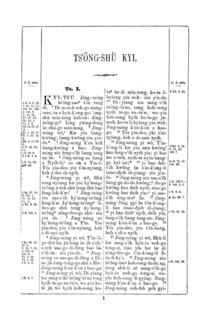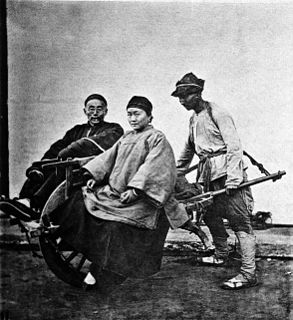
A changshan (help·info) is a traditional Chinese dress worn by men. In function, it is considered the male equivalent of the women's cheongsam (qipao). It is also known as a changpao or dagua. It was often worn by men with a magua or "riding jacket". These types of dress were widely adopted beginning under the Manchu rulers of the Qing dynasty, who required that men in certain positions wear this style.

Wu is a group of linguistically similar and historically related Sinitic languages spoken primarily in Shanghai, Zhejiang province, the southern half of Jiangsu province and bordering areas.
The Shanghainese language, also known as the Shanghai dialect, Hu language or Hu dialect, is a variety of Wu Chinese spoken in the central districts of the City of Shanghai and its surrounding areas. It is classified as part of the Sino-Tibetan language family. Shanghainese, like other Wu variants, is mutually unintelligible with other varieties of Chinese, such as Mandarin.

Xintiandi is an affluent car-free shopping, eating and entertainment district of Shanghai designed by global architecture firm Skidmore, Owings & Merrill. Xintiandi now refers to the wider area centered around Madang Road which includes both pedestrian-only and motor traffic roads.
Shanghainese people in Hong Kong have played an important role in Hong Kong since 1949.
Qian Nairong is a Chinese linguist. He received a master's degree in Chinese from Fudan University in 1981. He is a professor and the head of the Chinese Department at Shanghai University. He is an influential researcher and advocate of Shanghainese, a dialect of Wu Chinese.

The Ningbo dialect is a dialect of Wu Chinese, one subdivision of Chinese language. Ningbo dialect is spoken throughout Ningbo and Zhoushan prefectures, in Zhejiang province.

Shanghainese people are people of Shanghai Hukou or people who have ancestral roots from Shanghai. Most Shanghainese are descended from immigrants from all over China. Only a minority are Shanghai natives, those with ancestral roots in Shanghai.

Shanghai opera or Huju is a variety of Chinese opera from Shanghai, typically sung in Shanghainese. It is not to be confused with other Chinese opera genres popular in Shanghai, especially Yue opera. Unlike most forms of Chinese opera, Shanghai operas are typically set in the modern era, especially the Republican period.
Wuxi dialect is a dialect of Wu. It is spoken in the city of Wuxi in Jiangsu province of China.
Changzhou dialect, sometimes called Changzhounese, is a dialect of Wu, a Sino-Tibetan language family, and belongs to the Taihu dialect group. It is spoken in the city of Changzhou and surrounding areas in Jiangsu province of China. It has many similarities with the Shanghainese and Suzhou dialect. It is not at all mutually intelligible with Mandarin, China's official language. It is much more closely related to the neighboring Wuxi dialect with which it is mostly mutually intelligible.

Taizhou dialect is a dialect of Wu Chinese. It is spoken in the city of Taizhou in Zhejiang province of China. It is only partially intelligible with Shanghainese.
Shadi dialect is a Wu Chinese dialect spoken in Tongzhou, Haimen, and Qidong districts in southern Jiangsu as well as Chongming Island, Shanghai. It is considered to be a variety of Taihu Wu, which is intelligible with Shanghainese.
Taihu Wu (吳語太湖片) or Northern Wu (北部吳語) is a Wu Chinese language spoken over much of southern part of Jiangsu province, including Suzhou, Wuxi, Changzhou, the southern part of Nantong, Jingjiang and Danyang; the municipality of Shanghai; and the northern part of Zhejiang province, including Hangzhou, Shaoxing, Ningbo, Huzhou, and Jiaxing. A notable exception is the dialect of the town of Jinxiang, which is a linguistic exclave of Taihu Wu in Zhenan Min-speaking Cangnan county of Wenzhou prefecture in Zhejiang province. Used in regions around Taihu Lake and Hangzhou Bay, this group makes up the largest population among all Wu speakers. Taihu Wu dialects such as Shanghainese, Shaoxing and Ningbo are mutually intelligible even for L2 Taihu speakers.

Old Xiang, also known as Lou-Shao, is a conservative Xiang Chinese language. It is spoken in the central areas of Hunan where it has been to some extent isolated from the neighboring Chinese languages, Southwestern Mandarin and Gan languages, and it retains the voiced plosives of Middle Chinese, which are otherwise only preserved in Wu languages like Shanghainese. See Shuangfeng dialect for details.
Chicken and duck blood soup is a Shanghainese soup-based blood dish, using the blood of chicken and duck as a principal ingredient. Created by Xu Fuquan, a hawker from Shanghai, and described to be sour and spicy in taste, the dish is viewed as a healthy food with medicinal value in Shanghai.

The 2010 census put Shanghai's total population at 23,019,148, a growth of 37.53% from 16,737,734 in 2000. 20.6 million of the total population, or 89.3%, are urban, and 2.5 million (10.7%) are rural. Based on population of total administrative area, Shanghai is the second largest of the four direct-controlled municipalities of China, behind Chongqing, but is generally considered the largest Chinese city because Chongqing's urban population is much smaller.
Haipai refers to the avant-garde but unique "East Meets West" culture from Shanghai in the 20th and 21st centuries. It is a part of the culture of Shanghai.

Dandan noodles or dandanmian is a noodle dish originating from Chinese Sichuan cuisine. It consists of a spicy sauce usually containing preserved vegetables, chili oil, Sichuan pepper, minced pork, and scallions served over noodles. The dish can either be served dry or as a noodle soup.

The culture of Shanghai or Shanghainese culture is based on the Wuyue culture from the nearby Jiangsu and Zhejiang province, with a unique "East Meets West" Haipai culture generated through the influx of Western influences since the mid-19th century. Mass migration from all across China and the rest of the world has made Shanghai a melting pot of different cultures. It was in Shanghai, for example, that the first motor car was driven and (technically) the first train tracks and modern sewers were laid. It was also the intellectual battleground between socialist writers who concentrated on critical realism, which was pioneered by Lu Xun, Mao Dun, Nien Cheng and the famous French novel by André Malraux, Man's Fate, and the more "bourgeois", more romantic and aesthetically inclined writers, such as Shi Zhecun, Shao Xunmei, Ye Lingfeng and Eileen Chang.










